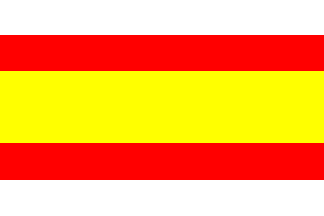 Shipmate Flagchart : http://www.flagchart.net
Shipmate Flagchart : http://www.flagchart.net
adopted 19 Sep 1961.

Last modified: 2014-06-28 by andrew weeks
Keywords: lemsterland | oosterzee |
Links: FOTW homepage |
search |
disclaimer and copyright |
write us |
mirrors
 Shipmate Flagchart : http://www.flagchart.net
Shipmate Flagchart : http://www.flagchart.net
adopted 19 Sep 1961.
ll.gif) International
Civic Arms : http://www.ngw.nl/
International
Civic Arms : http://www.ngw.nl/
Granted 25 Mar 1818.
![[Oosterzee village]](../images/n/nl-fr_oz.gif) image by Jarig Bakker, 8 Oct 2006
image by Jarig Bakker, 8 Oct 2006
Mr. Rudolf Broersma just sent me the image of the flag of Oosterzee,
a village in the municipality of Lemsterland.
The flag is: a blue hoist, at the fly 3 equally wide horizontal stripes
of green, white and black.
Oosterzee (Frisian: Eastersee) lies along the largest Frisian lake,
the Tsjûkemar (Tjeukemeer) and has c. 800 inhabitants divided into
the neighbourhoods Oosterzee-Buren and Oosterzee - Gieterse brug. The village
was formerly the seat of the "grietenij" (municipality) Lemsterland,
where since 1500 the "grietmannen" (Mayors) lived. It has a unique
church with a bell dating from 1498, and there is the Roordamonument
with the first stone of the Roordastate (fortified house).
The yachtharbour is appropriately located at the pub "Brette Hoanne"
(roasted cockerel).
The Gietersebrug is a reminder of peat-digging which took place there
in the 18th/19th century, mainly by Giethoorners (Overijssel). Peat made
place for milk, there arrived a dairy factory, a factory of agricultural
appliances and a Limnological Institute (Research in lake-water). Now all
factories and the Institute are closed, but MetaalPlus is using
the former dairy factory for its productions, while the village is preparing
facilities for yachting and other fun. Unfortunately the Tsjûkemar
is
unfit for yachting (under 1 m. deep), except for the canal Lemmer-Groningen
passing through it.
Source: village website.
Formerly the Oosterzeeïngerland belonged to the village, a large
stretch of meadows, which became peatland in the 19th century (now Bantega
village, some kms south), and reached till the Zuiderzee. Oosterzee was
the birthplace of Menso Poppius, a 16th century Calvinist preacher.
Count Willem I of Holland (1203-1222) built a castle here in 1197 for
his bride Adelheid van Gelre. At the time he was count of Oostergo and
Westergo.
Source: Encyclopedie van Friesland, 1958.
Jarig Bakker, 8 Oct 2006
Today (21 Nov 2005) the Society for Village interests (Plaatselijk
Belang) celebrated its centennium. During the celebration the new village
flag, designed by the Fryske Rie foar Heraldyk, was hoisted. Its
colors symbolize: blue for "zee" (sea), black for peat, green for
grass and white (silver) for money derived from all sources.
Source: Leeuwarder
Courant.
Stefan Lambregts, 9 Oct 2006